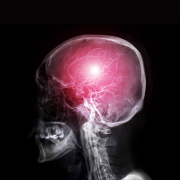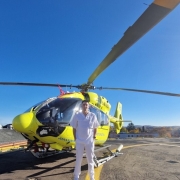Author Interview with Dr Johannes Kaesmacher
Author Interview with Dr Johannes Kaesmacher, from the University Institute of Diagnostic and Interventional Neuroradiology, University Hospital Bern, Inselspital, University of Bern, Switzerland
Interviewed by Nicolas Martinez-Majander, from the Department of Neurology, Helsinki University Hospital, Helsinki, Finland.
Paper: Mechanical Thrombectomy in Ischemic Stroke Patients With Alberta Stroke Program Early Computed Tomography Score 0-5, published recently in Stroke (March 3, 2019: https://doi.org/10.1161/STROKEAHA.118.023465)
First of all, thank you for making this interview possible. Could you start by telling a little about yourself and what are your main fields of interest in stroke medicine and research?
Sure, no problem. Currently, I am a working at the Department of Diagnostic, Interventional and Pediatric Radiology in Bern, finishing my general radiology training to become an interventional Neuroradiologist thereafter. Since 2016, my main fields of interest in stroke medicine and research have centered on mechanical thrombectomy (MT), especially regarding the definition of angiographic reperfusion success, the value of pre-interventional IV tPA and patient selection in general. Lately, I am also interested in outcome and infarct topography prediction using deep-learning approaches. Since 2017, I have been working together with Prof. Gralla and Prof. Fischer as a part of the SWIFT DIRECT trial (https://www.swift-direct.ch/the-swift-direct-trial/) core team. SWIFT DIRECT evaluates direct MT versus the bridging approach in mothership patients. This trial has also been the main project of my PhD in Clinical Sciences at the Graduate School of Health Sciences in Bern.
Why did you decide to write about ischemic stroke patients with low ASPECTS treated with mechanical thrombectomy? Why is this topic relevant?
Endovascular stroke treatment has historically been a frontier domain of Neuroradiology in Bern since the late 90s (initially intra-arterial Urokinase and since 2009/2010 stent-retriever thrombectomy) and eligibility criteria have been relatively broad. Consequently, we decided to systemically investigate the outcome of patients treated with MT, especially of those not meeting current top-tier guideline criteria. For this purpose, we have invited several university hospitals to participate in the BEYOND-SWIFT registry in order to provide a better understanding of how these patients do after MT and if successful reperfusion is associated with a clinical benefit. Given the low NNT in recent pivotal thrombectomy trials, it seems likely that more patients can benefit from MT than the patient cohort that was randomized in these trials. However, this observation should not routinely be put forward as the sole reason to treat patients outside current guidelines. Particularly in large infarct core patients, the risk of symptomatic intracerebral hemorrhage is a general concern.
You discussed about strengths and limitations of ASPECTS in your paper, could you tell more about that. And what are your thoughts on e-ASPECTS software performance?
There are many limitations to both, NCCT-ASPECTS and DWI-ASPECTS and both are partially related to the ASPECTS grading system, but also to modality inherent shortcomings. As a general concern, ASPECTS does not account for infarction other than the MCA territory, which obviously is a concern in Carotid-T occlusions. Moreover, ASPECTS is only a mediocre surrogate of volume and neglects eloquence and hence, long-term functional relevance. In my view, the cut-off as to when an ASPECTS area is rated as positive or negative also varies from observer to observer. Lastly, ASPECTS does not account for different vulnerability of grey and white matter, which has reach quiet some attention in perfusion imaging studies, but has not been implemented in current clinical practice so far. As of now, there is also evidence from thrombectomy cohorts that reperfusion can selectively salvage the white matter in a territory, while the grey matter had largely undergone infarction already. I think automated ASPECTS grading is important for future comparability and eases collection of registry data, if aimed for reducing interrater variance and no core-lab adjudication will be needed. I think there is robust evidence that e-ASPECTS or RAPID-ASPECTS do at least as well as experienced readers, and a recent analysis (Radiology 2019, Maegerlein et al) has put forward that it is even superior to expert readers in terms of infarct delineation/prediction within the first hours after symptom-onset.
Your paper interestingly showed that even in patients with ASPECTS 0-5, successful reperfusion is associated with superior outcomes and a better safety profile compared with patients in whom reperfusion was unsuccessful. Is there any research also on patients with low NIHSS score treated with mechanical thrombectomy?
We have evaluated the effect of successful reperfusion also in NIHSS<8 patients included into the BEYOND-SWIFT registry (https://link.springer.com/article/10.1007/s00415-018-09172-1), and comparable analyses have been performed by others. In patients with NIHSS<8, successful reperfusion was significantly related to mRS 0–1 (aOR 3.217, 95%-CI 1.174–8.816) and reduced the chances of non-hemorrhagic neurological worsening (aOR 0.194, 95%-CI 0.050–0.756). The effect remained tangible in the subgroup of patients with NIHSS < 6, however, there was large uncertainty according to the small sample size. Before we have a better understanding, which patients deteriorate, and which do not, I think there is scientific equipoise regarding the two following treatment approaches: (1) Subjecting all patients with acute LVO to MT, thus putting patients at an interventional risk, who would have reperfused spontaneously or after IVT treatment at comparable time points; (2) Only subject patients to MT if they experience clinical deterioration, implying that reperfusion will be achieved later and risking that additional tissue will undergo infarction. Recent data from the ETIS Registry, also found comparable outcomes across centers applying the two different approaches in France (Darganzanli et al. STROKE), further stressing the need of randomized-controlled trials evaluating these treatment concepts in a systematic manner.
You had excellent sensitivity analyses e.g. about the effect of imaging modality (NNCT-ASPECTS vs DWI-ASPECTS) on the results. Could you go through it again? Would you recommend MRI for all acute stroke patients?
A beneficial effect of achieving successful reperfusion was tangible in patients with NCCT-ASPECTS 0-5 and DWI-ASPECTS 0-5, and interaction analyses failed to provide hints towards heterogeneity of effect of achieving successful reperfusion. However, NCCT-ASPECST 0-5 patients in general had worse outcomes as opposed to DWI-ASPECTS 0-5 patients, reflecting that DWI-ASPECTS 0-5 will most likely include patients that would have been rated ASPECTS 6 or even 7 when using CT. Although pre-interventional MRI is the imaging of choice in Bern, I do not think there is any robust evidence supporting that pre-interventional MRI is associated with superior patient selection. To shed light onto this question in terms of observational data, I think we urgently need better follow-up of patients, who were not selected for endovascular treatment, as most registries now are confined to patients actually receiving endovascular treatment. In the end, a properly designed RCT will required to answer this question in a more definitive manner, and, as far as I know, some are already being planned.
Your paper was about anterior circulation strokes like all the previous large thrombectomy trials. To your knowledge, are there any ongoing randomized trials on acute posterior strokes? Are these patients treated with thrombectomy in your center?
In Bern, all patients presenting with basilar artery occlusions are generally considered as potential candidates for endovascular treatment. There have to be good reasons to exclude patients presenting with a BAO from MT and most institutions I know exclude patients when there is clear evidence of wide-spread, irreversible tissue damage within the pons or midbrain. However, it should be kept in mind that DWI lesions can be occasionally reversible, especially in white matter tracts, which constitute the majority of tissue volume within the brainstem. Apart from basilar artery occlusions, vertebral artery occlusions, tandem posterior occlusions, and isolated P1/P2 occlusions are also treated endovascularly in Bern on-case-by-case decision and selection.
Once again congratulations on your research and thank you for this interview!


